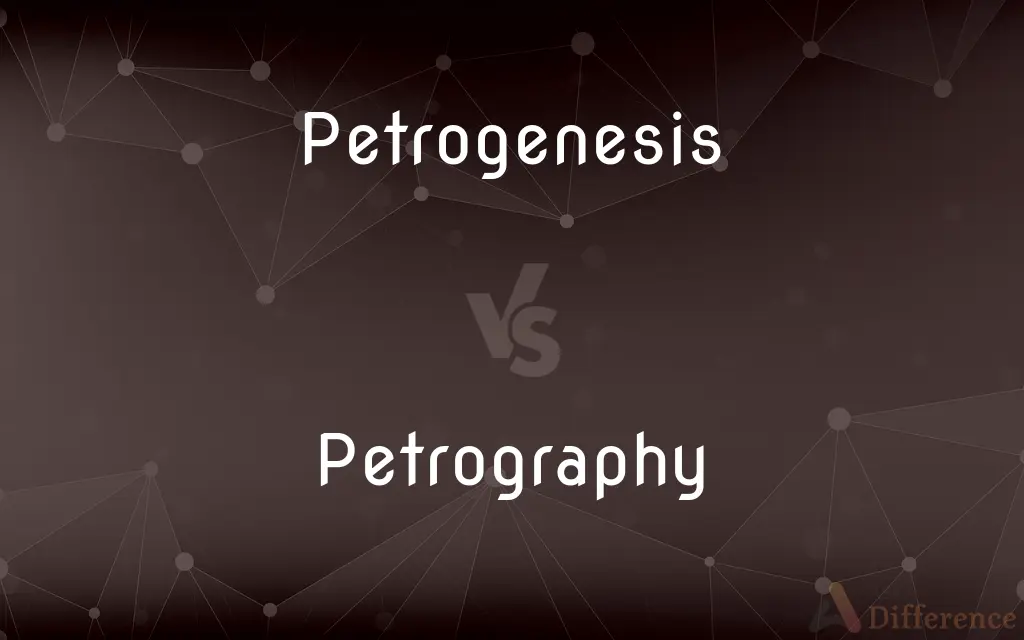Petrogenesis vs. Petrography — What's the Difference?
By Tayyaba Rehman & Urooj Arif — Updated on April 23, 2024
Petrogenesis explains the formation and chemical composition of rocks, whereas petrography focuses on describing rock characteristics through microscopic analysis.

Difference Between Petrogenesis and Petrography
Table of Contents
ADVERTISEMENT
Key Differences
Petrogenesis is the study of how rocks form, including their origins and evolution through geological processes. Whereas, petrography examines the description and classification of rocks by studying their mineral content and texture.
Petrogenesis often involves geochemical analysis to understand the processes that lead to the formation of different rock types. On the other hand, petrography utilizes microscopic techniques to identify the minerals and structures within the rocks.
In petrogenesis, researchers focus on the conditions under which rocks form, such as pressure, temperature, and chemical environments. Whereas petrography provides detailed visual and microscopic descriptions of rock samples, which are crucial for identifying rock types.
Petrogenesis helps in understanding the larger geologic context of rock formations, including tectonic settings and magmatic histories. Petrography, on the other hand, often serves as a tool to support these interpretations by providing empirical evidence from rock specimens.
While petrogenesis can predict rock types in different geologic settings based on theoretical models, petrography relies on actual samples to classify and study rock textures and structures in detail.
ADVERTISEMENT
Comparison Chart
Focus
Formation and evolution of rocks
Description and classification of rocks
Methods
Geochemical analysis, theoretical models
Microscopic analysis, visual examination
Outcome
Understanding of rock forming processes
Detailed rock descriptions and classifications
Application
Geologic history, tectonic settings
Mineral identification, textural analysis
Key Techniques
Isotope geochemistry, thermodynamic modeling
Thin section microscopy, photomicrography
Compare with Definitions
Petrogenesis
The study of rock origins and development.
Petrogenesis involves analyzing how magma crystallizes to form igneous rocks.
Petrography
Utilizes thin sections of rocks.
In petrography, thin sections allow for detailed examination under a microscope.
Petrogenesis
Involves modeling of geologic processes.
Models in petrogenesis help predict the types of rocks that form under specific conditions.
Petrography
The microscopic study of rock samples.
Petrography is essential for identifying mineral components within a rock.
Petrogenesis
Focuses on the conditions that form rocks.
Petrogenesis research often looks at the role of pressure and temperature in rock formation.
Petrography
Essential for detailed rock analysis.
Petrography provides the fine details needed to understand rock fabric and history.
Petrogenesis
Related to geochemistry and geophysics.
Petrogenesis often uses geochemical data to understand rock compositions.
Petrography
Focuses on rock classification and description.
Petrography helps geologists classify rocks based on their texture and mineral content.
Petrogenesis
Important for understanding Earth's crust.
Petrogenesis provides insights into the processes that shape the continental and oceanic crust.
Petrography
Aids in supporting geological interpretations.
Petrography can verify theories about rock environments from petrogenesis studies.
Petrogenesis
Petrogenesis, also known as petrogeny, is a branch of petrology dealing with the origin and formation of rocks. While the word petrogenesis is most commonly used to refer to the processes that form igneous rocks, it can also include metamorphic and sedimentary processes, including diagenesis and metamorphic reactions.
Petrography
Petrography is a branch of petrology that focuses on detailed descriptions of rocks. Someone who studies petrography is called a petrographer.
Petrogenesis
The branch of petrology that deals with the origin of rocks, especially igneous rocks.
Petrography
The description and classification of rocks.
Petrogenesis
The branch of petrology dealing with the origin of igneous rocks.
Petrography
(petrology) The branch of petrology that deals with the scientific description and classification of rocks.
Petrography
The art of writing on stone.
Petrography
The art of writing on stone.
Petrography
The scientific description of rocks; that department of science which investigates the constitution of rocks; petrology.
Common Curiosities
Can petrography determine the origin of rocks?
While petrography can provide detailed descriptions, it does not specifically determine rock origins; that’s more the realm of petrogenesis.
How does petrogenesis contribute to understanding Earth's geologic history?
By studying rock formation processes, petrogenesis contributes to broader geological models that explain Earth's structure and evolutionary history.
What is the main focus of petrogenesis?
Petrogenesis focuses on understanding how and why rocks form, studying the processes and conditions like temperature and pressure.
Why is geochemical analysis important in petrogenesis?
Geochemical analysis helps identify the chemical components and isotopic signatures that reveal the conditions under which rocks formed.
What kind of rock samples are best for petrography?
Rocks with well-preserved textures and mineralogy are ideal for petrographic analysis to ensure accurate classification and study.
What is a thin section in the context of petrography?
A thin section is a very thin slice of rock, prepared specifically for examination under a microscope in petrography.
What tools are essential for petrography?
Microscopes, especially polarizing microscopes, are essential tools for petrography to examine thin sections of rocks.
Are petrography and petrogenesis used in oil and gas exploration?
Yes, both disciplines are critical in determining the types of rocks present in a potential drilling area and understanding their formation processes.
How does petrography help in geology?
Petrography aids in classifying and describing rocks by analyzing their mineral content and structure under a microscope.
What types of rocks are most commonly studied in petrography?
Igneous, metamorphic, and sedimentary rocks are all studied in petrography to identify their mineral content and texture.
What is the role of temperature in petrogenesis?
Temperature influences the crystallization and melting of minerals, playing a crucial role in rock formation processes studied in petrogenesis.
What is the importance of structural analysis in petrography?
Structural analysis in petrography helps understand the deformation history and mechanical properties of rocks, which are crucial for various applications.
How do petrography and petrogenesis complement each other?
Petrography provides the detailed empirical data needed to support or refute the theoretical models used in petrogenesis.
How does pressure impact rock types in petrogenesis?
Pressure affects the stability of mineral phases and can lead to the formation of different rock types at varying depths.
How does petrogenesis address environmental issues?
Petrogenesis can help understand geological processes that might influence climate change, natural disasters, and resource distribution.
Share Your Discovery

Previous Comparison
Ton vs. Tonne
Next Comparison
Humph vs. HmphAuthor Spotlight
Written by
Tayyaba RehmanTayyaba Rehman is a distinguished writer, currently serving as a primary contributor to askdifference.com. As a researcher in semantics and etymology, Tayyaba's passion for the complexity of languages and their distinctions has found a perfect home on the platform. Tayyaba delves into the intricacies of language, distinguishing between commonly confused words and phrases, thereby providing clarity for readers worldwide.
Co-written by
Urooj ArifUrooj is a skilled content writer at Ask Difference, known for her exceptional ability to simplify complex topics into engaging and informative content. With a passion for research and a flair for clear, concise writing, she consistently delivers articles that resonate with our diverse audience.















































